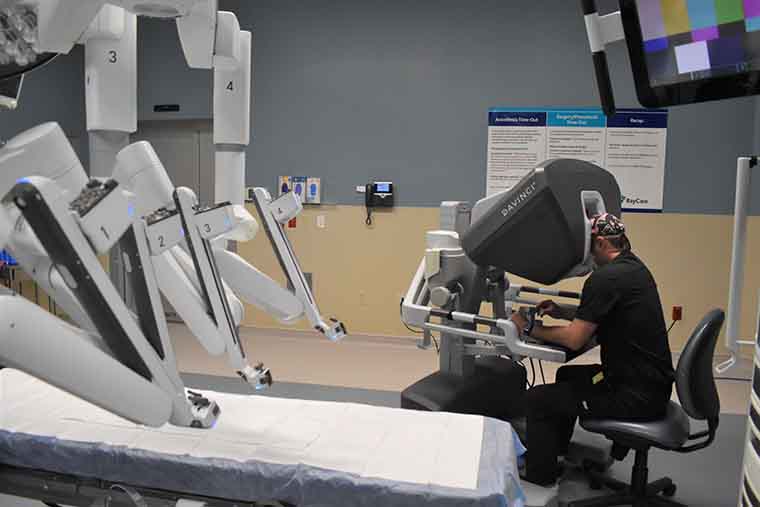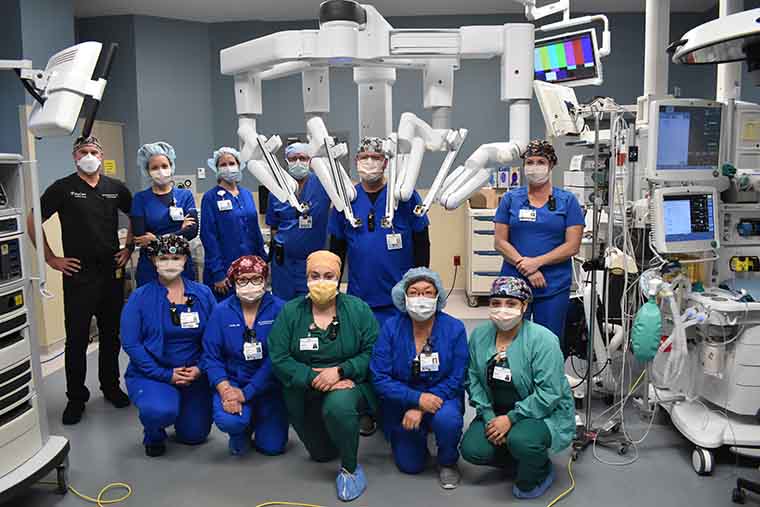St. Joseph's Hospital-North Adds Second High-Tech Surgical Robot

The hospital began using its first da Vinci® Xi™ in June 2020 and added a second in late December 2021.
Robotic surgeries performed at the hospital include general surgery, urology, gynecology and gynecological oncology. In 2021, St. Joseph’s Hospital-North performed 533 robotic surgeries by 11 surgeons. By comparison, St. Joseph’s Hospital-North performed 282 robotic surgeries in 2020 and 263 in 2019.
“Over the past year, we’ve nearly doubled our robotic surgery volume,” said Hännah Denton, St. Joseph’s Hospital-North operating room nurse manager. “Having one robot with our high volume of cases was beginning to cause an extended wait time for patients to be scheduled for surgery.”

“Being able to provide increased surgical time and availability with two robotic systems continues to build our relationships within the physician groups as well as the community,” Denton said. “It’s evidence showing we have the resources here and available to assist us in giving the best and safest care we can to our patients.”
The surgical robot provides superior dexterity, enhanced vision and improved surgical access compared to conventional minimally invasive surgery or traditional open surgery. The surgeon operates the robot from a console that has four interactive arms and a high-resolution screen that projects 3-D-HD images of the surgical site. The vision system provides surgeons a highly magnified view, virtually extending their eyes and hands into the patient.
The surgeon is 100 percent in control of the robotic-assisted system and manually operates surgical instruments. The instruments work identically to the movement of a human arm, human elbow and a human wrist, however with an enhanced range of motion and operative reach. When the surgeon moves, the instruments respond precisely to those movements in real time. The robot navigates a precise approach to areas that traditional surgical instruments are unable to reach.

Benefits of robotic surgery for patients are substantial:
- Precise surgical incisions, allowing unhealthy tissue to be removed without affecting surrounding healthy tissue
- Smaller incisions causing less trauma and less post-operative pain to a patient’s body
- Smaller incisions that alleviates blood loss and lowers infection risk
- Robotic surgeries may result in a shorter length of stay in the hospital
- Recovery from robotic surgery may be quicker due to smaller incisions
- Smaller scars result from robotic surgeries
“Robotics is the next step past laparoscopic surgery,” said BayCare Medical Group surgeon Dr. Brett Armstrong who performs robotic surgeries at St. Joseph’s Hospital-North. “It allows us to do a lot more in-depth surgery with minimally invasive incisions that results in less painful surgery.”
“We have capability doing robotic surgery because we can use full articulation of the instruments inside to sew, which you cannot do laparoscopically,” said Dr. Armstrong who has performed robotic surgeries for six years. “We can also access multiple areas of an abdomen using the robot whereas you would have to put in more ports if you were doing it laparoscopically.”
“We have more technology with the robot,” he said. “It allows us to see structures correctly that otherwise we would not be able to see. We can confirm (with robotic surgery) that there is adequate blood supply. Overall, it’s safer to do surgery robotically.”
Visit StJosephsNorthRobotics.org for more information about robotic surgery at St. Joseph’s Hospital-North.
Other BayCare hospitals with at least one or multiple da Vinci Xi robots are: Bartow Regional Medical Center, Mease Countryside Hospital, Morton Plant Hospital, Morton Plant North Bay Hospital, South Florida Baptist Hospital, St. Anthony’s Hospital, St. Joseph’s Hospital, St. Joseph’s Women’s Hospital, St. Joseph’s Hospital-South and Winter Haven Hospital.
For more on robotic surgery at BayCare hospitals visit:
https://baycare.org/services/surgery/robotic-surgery
